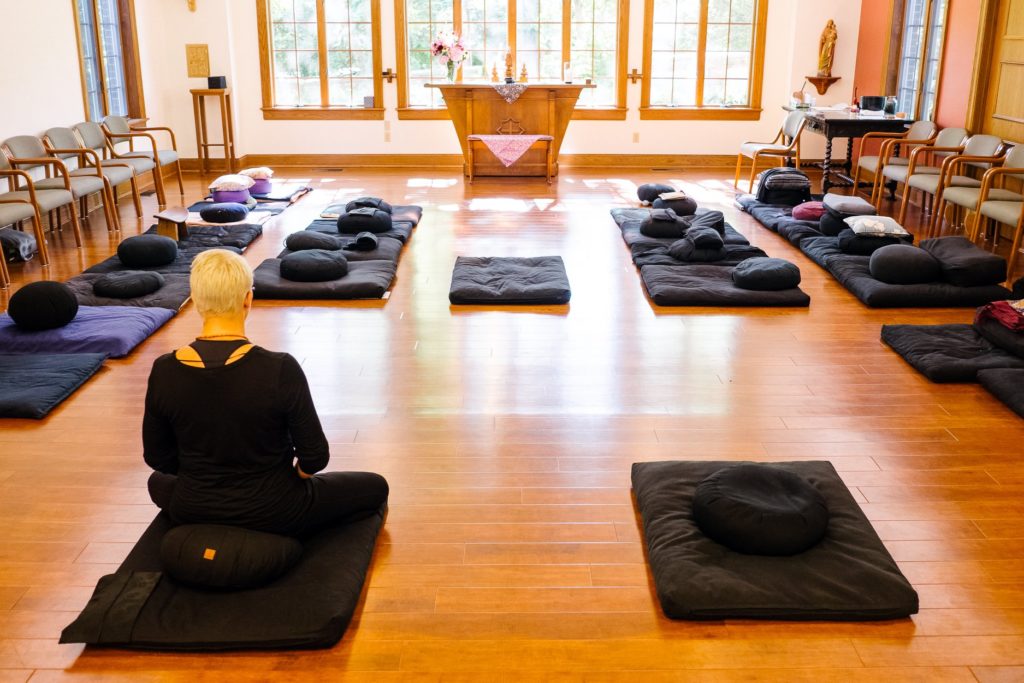
Practicing Zen is zazen. For zazen a quiet place is suitable. Set aside all involvements and let the myriad things rest. – Dogen Zenji, “Rules for Zazen”
To start, let go of the ideas you may have about what meditation is supposed to look like or what meditation is supposed to feel like. Let the monkey in your mind go to sleep so that you can wake up and reclaim your rightful home.
Unless you have a meditation cushion, or zafu, do not attempt to sit cross-legged on the floor to meditate. Without adequate support to elevate your buttocks and enable you to anchor your knees on the floor, sitting this way quickly becomes painful. The point of meditation is not pain. Your life is painful enough as it is. The point of meditation is to relieve pain.
What follows are instructions for meditating in a chair. Although you are unlikely to have the perfect chair in your home for meditation, any chair is perfectly okay. So do not delay your practice until your trip to the Furniture Mart.
1. Sit on the forward third of a chair so that your feet rest firmly on the ground. To support your back, place a hard cushion between your spine and the chair back. This will prevent slouching and keep you alert.
2. Space your feet widely apart. Your body is now supported at three points: your two feet and your bottom. In seated meditation, three contact points are essential for endurance and comfort. Your body now evokes the strength of a mountain.
3. Place your hands in the middle of your lap as follows: first, your right hand, palm up; then, your left hand, palm up, resting in your right palm. Lightly touch the tips of your thumbs together. Holding your hands in this way calms agitation and restlessness.
4. To check your posture, align your ears with your shoulders. Align your nose with your navel. Tuck your chin in slightly. Hold your head as though it were supporting the sky, and it will neither hang forward nor fall backward.
5. Relax your belly. A stiff, cinched abdomen restricts your breathing. In meditation, you will try to return to the full, rounded breathing of a baby. Watch a baby breathe and see that the belly rises on inhalation, not the chest. This is a good demonstration for you to learn from.
6. Lower your gaze, but do not close your eyes. If you close your eyes, you will be lulled into daydreaming. Meditation is not practice for sleeping; it is practice for waking up. Look at a spot on the floor or on a wall in front of you. Any spot will do, as long as it is not distracting.
7. Close your teeth and your mouth. Take a breath and exhale completely.
8. On your next inhalation, silently count “one.” When you exhale, silently count “two.” Inhale counting “three.” Count each exhalation and inhalation up to “ten” and then start back at “one.” If you lose the count, begin again at “one.” This meditation practice is called counting your breath.
9. When a thought comes up, let it go away by itself, which it will if you do not pursue it.
10. This is the practice of zazen. Do zazen for up to five minutes. Keep a watch or clock nearby to note the time. As you meditate more often, you may be able to do it for longer. Do not be self-critical or impatient with yourself. Do not push yourself. Do not make meditation one more thing you have to do. If you are gentle, encouraging and consistent with yourself, your meditation practice will naturally deepen and lengthen.
Five minutes is not a long time, but it can take a long time to find five minutes to meditate. Usually, the first five minutes or the last five minutes in the day are the easiest to find. You already have them and they are already quiet.
I will be most happy to answer your questions and encourage you to keep going.














